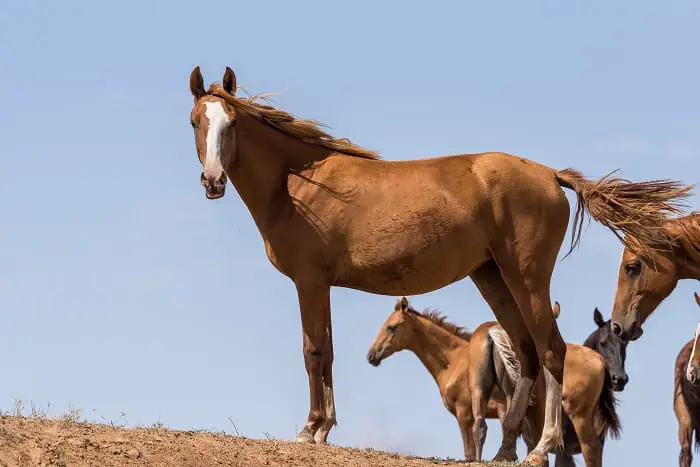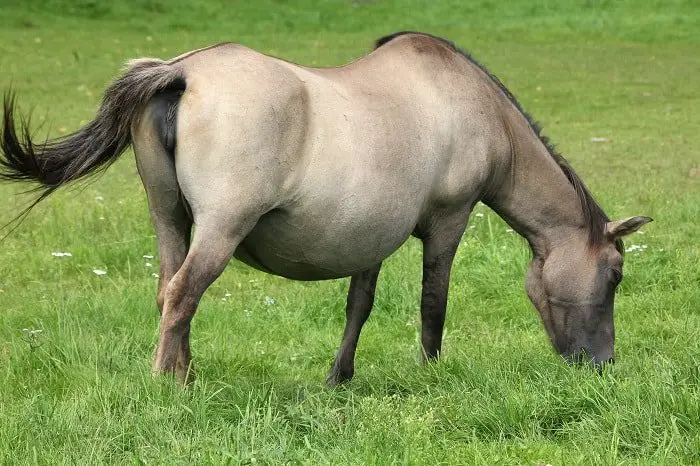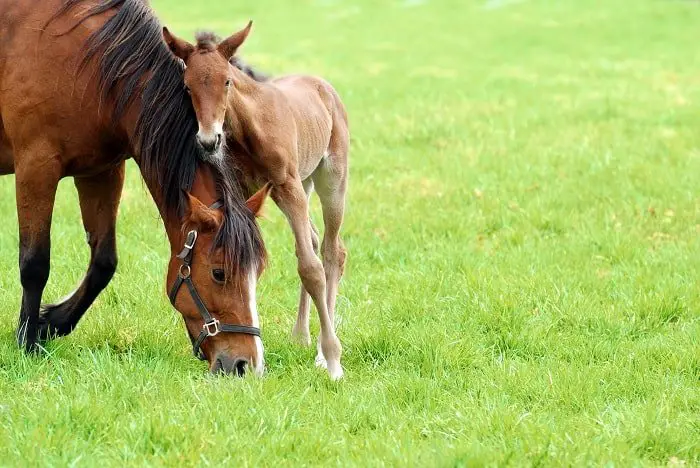Last Updated on February 27, 2023
How long do horses stay pregnant? How do you know when a horse is going to give birth? How do you know if a horse is pregnant? If you’re new to the world of horse breeding, you’ll no doubt have many questions like this!
Whether breeding for pleasure, performance, or show, careful consideration is taken into the whole breeding process. A lot of time, money, research and care is required to breed the best possible horse to suit your requirements. With all the work that goes into breeding, it can be a very expensive and risky business!
Whether you planning on breeding a foal of your own, or are just curious about how long horses stay pregnant, we’ve got all the answers for you right here.
How Long Do Horses Stay Pregnant?
Like most larger mammals, horses typically have quite a long pregnancy. The length of time a horse is pregnant is called the gestation period, and in horses, this typically lasts for around 11 months. This equates to a horse gestation period in days of 330 days on average.
However, the length of time horses stays pregnant can vary widely from this! The gestation period for a horse can range from 320 to 380 days, making it difficult to figure out when a horse is going to give birth. Factors that affect the length of pregnancy include the type and breed of horse, the time of year the mare becomes pregnant, and the health and condition of the mare.
How Many Foals Can a Horse Have?
Most mares only carry one foal per pregnancy, though twins do happen on rare occasions. Due to the long gestation period, a horse can only have one pregnancy a year and generally only have one foal a year.
What is a Horses Gestation Period? Gestation Stages Explained
A mare will go through three different trimesters during the gestation period. The first trimester begins with conception and the pregnancy is generally confirmed two weeks after conception. During the first trimester, it is important to have a vet check your mare to monitor the health of her and her foal.
As early as 26 days after conception, a vet can perform an ultrasound that detects a heartbeat and can confirm vitality. At this time, your vet will also check if the mare is carrying twins. By three months, the shape of the foal starts to look like a horse, developing key features, and the gender of the foal can sometimes be identified.
The second trimester of pregnancy starts at around day 114. During this time, the mare should receive essential dewormer and vaccinations. The mare’s feed should be increased slightly to provide essential nutrition for the fast-growing foal. By six months, the mare begins to look more obviously pregnant, with a larger abdomen.
The third trimester starts at approximately day 226 of the pregnancy. During the third trimester, the foal is growing rapidly and it is important to closely monitor the health and body weight of your mare. Up until around the seventh month of pregnancy, you can gently exercise your mare, but after this, she should be allowed to rest at the pasture.
As your mare nears giving birth, it is important to keep her in a comfortable and stress-free environment. Avoid any big changes or stressful experiences, and stick to a routine. If you’re planning on moving the mare before the birth, make sure to do this several weeks before the foal is expected to be born.
Find out What Time Of Day Do Horses Give Birth?
How to Know if a Horse is Pregnant
Horses do not look pregnant until the end of the second trimester of pregnancy, which can make it difficult to tell if a horse is pregnant. It is not uncommon for a mare to give birth without her owners or carers even knowing she was pregnant!
One tell-tale sign that a horse is pregnant is when a mare no longer comes into season. During the spring and summer months, a mare will come into season every three weeks or so – this is part of her reproductive cycle, and it will continue to happen until she falls pregnant.
If you suspect that your horse may be pregnant, you will need a veterinarian to confirm the diagnosis. During the very early stages of pregnancy, an ultrasound scan may be required to see if she is pregnant or not. In the latter stages, the veterinarian may be able to palpate the foal and confirm that the mare is pregnant.
When Do Horses Get Pregnant?
Horses normally get pregnant during the summer months to guarantee a spring or early summer birth. This allows the mare to have access to fresh, nutritious grass, providing essential energy for her to feed the foal. The foal will receive almost all its nutrition for the first six months of life from the mare’s milk, so she needs a lot of energy to compensate for this.
A spring birth also means that the young foal will not have to endure cold winter temperatures. Foals are not able to retain their body heat as efficiently as older horses, and a young foal can quickly become hypothermic in cold, wet weather conditions.
When Do Mares Come in Heat? Seasonal Polyestrous Explained
The breeding cycle of a female horse is described as seasonally polyestrous. The term seasonal polyestrous may sound complicated, but it simply means that horses go into heat (estrus) during the spring and summertime. When a horse is in the heat it means that they are sexually receptive and fertile. Heat cycles generally happen every three weeks during the spring and summer.
Some horse breeders, especially those who breed Thoroughbreds, try to manipulate a horse’s breeding cycle. They use artificial light to stimulate the longer days of spring and summer to convince the mare to go into heat earlier. This allows the foal to be born earlier in the year, which can be a huge advantage for racehorses.
Can Horses Have Twins?
On rare occasions, a horse may conceive twins, but it is highly unusual for a horse to give birth to healthy twin foals. In most cases, twins occur because a mare has ovulated twice, producing two eggs from one ovary. Identical twins are rarely formed from a split embryo.
Unfortunately, during most twin pregnancies the foals do not survive, as the uterus of a horse is not large enough to carry two babies. One of the first things a vet will check for when examining a pregnant mare is whether or not she is carrying twins. If twins are found, your vet may remove the second embryo to give the other one a fighting chance. A mare may also abort twins within the first trimester.
In many cases, if a horse carries twins to full term, several complications can occur for both mother and baby. The birth itself may be complicated, requiring veterinary intervention or a cesarean section to deliver foals. If the foals are born alive, they are highly likely to suffer from abnormalities such as malformed limbs.
There are a few cases where a mare can give birth to healthy twins. However, if your mare is pregnant with twins, it is best to consult your vet to ensure a healthy pregnancy for your mare.
How to Tell When s Mare is Giving Birth
As your mare continues into the third trimester, you’ll need to make sure you are fully prepared for the arrival of the foal. After about day 315, you should carefully watch your mare for signs of foaling, as the foal will likely come around day 330. It’s not uncommon for a mare bred early in the year to carry a week longer, and for a mare bred in late spring or summer to have a shorter gestation period.
Signs a Mare is About to Give Birth
In the days leading up to the birth, your mare will likely show signs that she is ready to foal. Her udder will likely look full and may drip some milk. Her belly will likely look like it has dropped, as the foal gets ready to come out.
It is best to give your mare a large stall, covered in straw, with access to fresh water and hay. This will give the mare a comfortable place to give birth.
As the mare begins to go into labor, she will likely paw the ground and appear restless. She may get up and down a few times, but she will give birth laying down.
The amniotic sac is generally the first part visible, followed by the head and legs. Once the amniotic sac is visible, it is generally a few minutes until the horse is born.
A Beautiful New Life
Having a foal arrive is a truly exciting time. Generally, within an hour of the foal being born, it will be able to stand up and shortly thereafter, walk around. Within two hours the foal should be contently nursing.
It is always a good idea to have your vet there when your mare goes into labor. Your vet will be able to help with anything that may go wrong during birth and assess the health of the foal once it is born.
Summary – How Long Do Horses Stay Pregnant
Though a horse is generally pregnant for 10-11 months, it still may give birth to a healthy foal before or after that time. It is important to provide your mare adequate care during her pregnancy to help her give birth to a healthy foal. During the delivery itself, it is important to know the stages of labor, so you can get veterinary assistance if things do not progress as expected.
Please comment below if you enjoyed this article or have any remarks regarding this article!
How long can a mare go past her due date?
This is a very important question, because it can have a lot of repercussions. If a mare goes far past her due date, her health can be at risk, as will the foal. A mare that goes past her due date may have reduced blood flow to her uterus, which can cause the placenta to rupture. They can also have complications with their foals, such as difficult births, retained placenta, and fetal distress. Most foals born after an extended gestation are small in size due to delayed uterine development. However, most mares will gestate a bit longer than 11 months although even gestation periods of 380 days are still considered normal. The longest successful gestation recorded so far was 445 days.
How many babies can a horse have at once?
Horses normally only have one baby at a time. It can happen, though, that a mare start growing more than one embryo. However, in this case they will most likely abort during the later stages of the pregnancy. Twin pregnancies are in general extremely undesirable in horses, as they almost always have a bad outcome. The foals usually die within 24 h of birth and the mares can suffer from a variety of disorders, including abortion and retained placenta. They can already suffer from a variety of problems during gestation period, such as uterine torsion, fetal distress, and dystocia.
How do you calculate a foaling date?
If you want to calculate the estimated delivery date, take the mating date and add 338 days or 11 months to get the foaling date. In case you want to calculate the full range of possible foaling days follow next steps: for the earliest possible foaling take mating date and add 331 days. For the latest possible foaling take mating date and add 346 days. In most cases it will be impossible to accurately predict the foaling date so take those numbers more as a guidance and pay attention to your mare’s behavior and make sure she has everything she needs.
How can you tell how far along a horse is pregnant?
Within three weeks of the mare’s covering, a rectal examination is needed to determine if a mare is in gestation. To conduct a rectal examination the vet needs to place his hand in the rectum to palpate the uterus and assess its size, shape and also any swelling of the ovaries. During the second trimester of pregnancy, the uterus will appear to be enlarged and have a more rounded appearance, with a firm consistency. As the pregnancy continues, there will be an increase in the size of the uterus, with a softer consistency. The vet will palpate the abdomen, feel the fetus and listen to the heart rate with a stethoscope.
Michael Dehaan is a passionate horse owner, horse rider, and lover of all things equine. He has been around horses since he was a child, and has grown to become an expert in the field. He has owned and ridden a variety of horses of different breeds, and has trained many to compete in shows and competitions. He is an experienced horseman, having worked with and competed many horses, including his own. He is an active member of the equestrian community, participating in events and teaching riding lessons.


